Smartwater Bottles
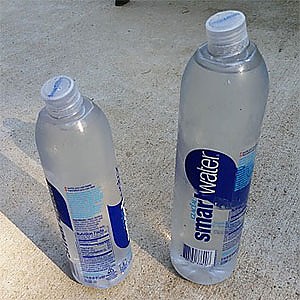
I switched from Nalgene to disposable water bottles for most (3+ season) trips. If you go that route, the Smartwater bottles are the sturdiest disposables out there except for Gatorade/Powerade, but have some distinct advantages over those brands. They are my regular water bottle on the majority of trips and haven't let me down, and at least let me reuse, rather than just recycle, if I have to buy bottled water sometimes.
Pros
- Lightweight
- Sturdy (for the type of bottle)
- Flip cap option
- Fit a Sawyer water filter
- Easy to get in/out of side pack pocket
- Price
- Avoids recycling if you have one already
- Comes with free water!
Cons
- Long term durability (extended trips)
- Not good for winter use
- Potential BPA/other plastic chemicals
- Can't take boiling water
- Thin mouth
- Not environmentally sustainable!!!!
Note that there is a recognized health risk associated with reuse of disposable bottles due to the release of BPA and other chemicals. Other research indicates there may be other issues associated with BPA Free bottles as well (due to the use of BPS and BPF). This review is not a recommendation to use these type of bottles and ignore these risks. It is a comparison of this bottle vs other disposable/recyclable bottles and not an endorsement of the practice (and certainly not a recommendation by Trailspace or any staff or members). You should thoroughly research the safety of this practice before making a decision to take this approach.
Please note that this review is not about the water itself, but the bottle. Also, the rating is not a comparison of a recyclable/disposable bottle versus a designed bottle such as the ever present and indestructible Nalgene. The rating is based on a comparison to other disposable bottles. That is why there is a long list of inherent weaknesses for the TYPE of bottle but my rating is high. I am not sure you can consider the Smartwater, or any, disposable bottle as "Gear," but since these are really prevalent now I thought it would be good to review.
Water bottles have evolved a lot since I started backpacking, from metal canteens to the white plastic bottles with inner plug and outer cap, to Nalgene products. Now you see a lot of disposable water bottles on the trail, which I admit to having carried for about 5 years in combination with other water storage. Thought it was time to review my current favorite...Smartwater.
Summary:
If you are going to carry disposable water bottles as part of your kit, you can't do much better than the Smartwater series. For this class of cheap bottle, they are extremely light, sturdy, adaptable (different caps, accept the Aquaclip, and fit a Sawyer filter), and easy to use. Their negatives are basically the same for any disposable bottle: long term durability, three-season limits, potential release of chemicals, and not environmentally sustainable.
I would recommend these if you like to carry disposable bottles, as part of a storage system that also includes something like a Platypus SoftBottle and maybe a regular Nalgene, for short to mid length trips from spring through fall. For those of you doing long distance hikes, I will let your experience guide you on the increased risk of failure. In winter, I recommend switching back to sturdier options that can handle boiling water and freezing temperatures.
And of course, in the quest to have less environmental impact, I can't recommend purchasing these specifically for equipment but rather using them if you happen to have to buy a drink in a gas station so you can reuse rather than recycle the bottle.
Specs:
The Smartwater series of water bottles come in a range of sizes including 1 liter, 750 ml, and 591 ml. I use all three depending on the length of trips and terrain/availability of water.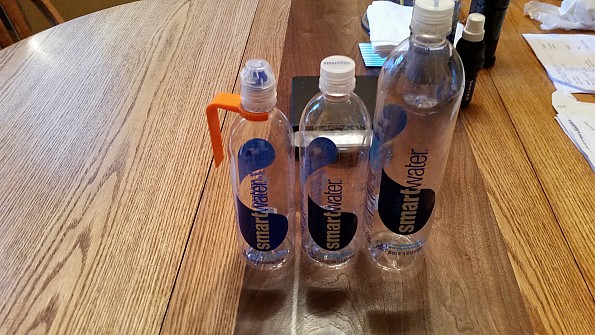
Weights range from 1 3/8 oz to 1 oz depending on the size and cap. Basically they weight almost nothing — the picture below is the 750 ml version.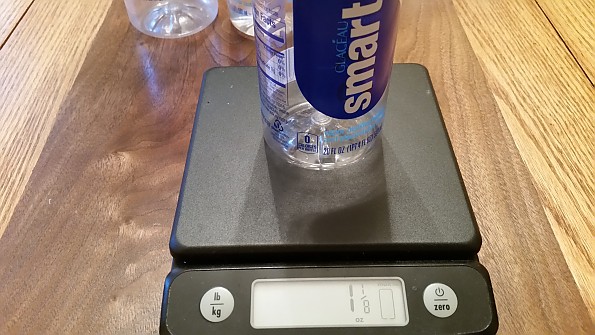
Durability:
The construction is sturdy compared to most water/soda bottles you can buy in the store/gas station. Gatorade and Powerade bottles are even sturdier, but slightly heavier (I don't really consider a few grams an issue but some might) and don't have some of the benefits listed below (the reason I prefer Smartwater). These bottles can be squeezed and do show some creases (hope you can see them in the picture below) but I have never had one fail.
I use these with my Sawyer filter a lot and put them through a significant amount of squeezing and pressure without an issue. The 1-liter size works best with the Sawyer as it has a greater length to squeeze.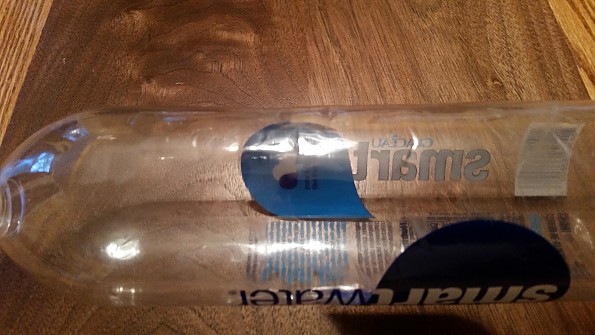
I have dropped them many times on rocks, hard ground, concrete (loading the car), etc. and none have broken. The longest trip I have taken using these as the primary water holder is five nights, but I have reused several bottles for at least a year before changing out just in case.
I filled a 750 ml and 1 liter bottle and did a little "testing" on my concrete patio. Both bottles were dropped, full of water, from a height of about 8 ft (as high as I can reach). First test was right side up, followed by a drop directly on the caps. 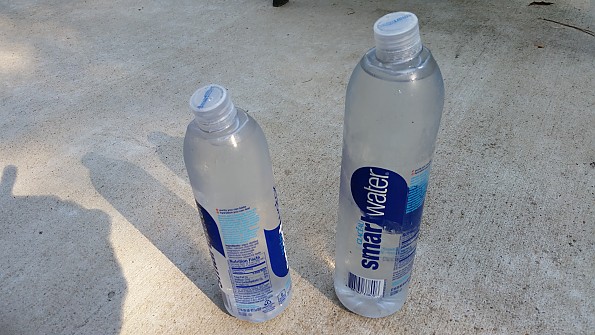
As you can see, the bottles were deformed after testing — the 750 ml bottle was bulged out a little on the bottom (slight slant in the picture) after the first drop, and both caps were compressed in by the second test when dropped directly on the cap. These issues were fixed easily in a couple of seconds, and both bottles recovered to their original shape: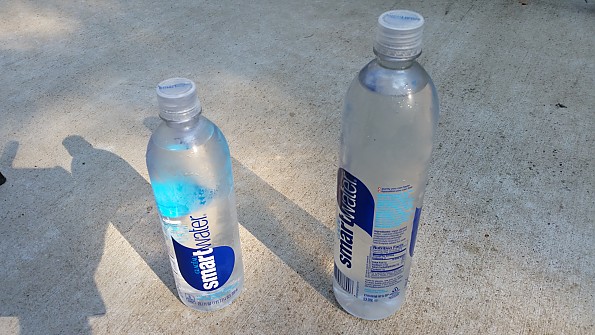
The cap-drop test did scuff up and damage both caps, but the integrity of each seemed unaffected. I guess if you had worries/issues you could carry an extra cap for almost no additional weight in your repair kit.
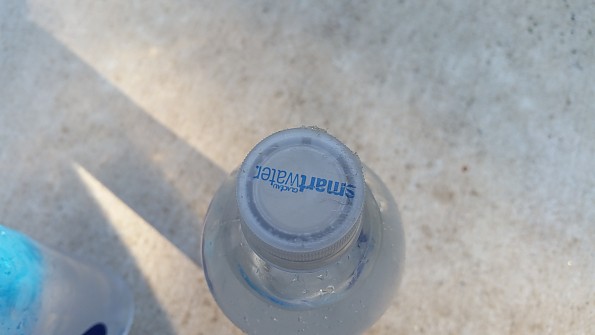
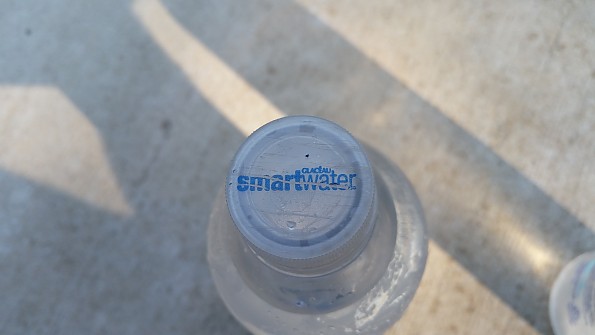
Overall sturdiness is excellent for this type of bottle but obviously doesn't compare to Nalgene or other designed bottles. I often carry the 1L version in my side pack pocket and do a lot of off-trail hiking which sometimes lands me in brush terrain. These bottles have been poked and prodded by branches and snagged by vines and briers, but have not been damaged yet.
Benefits:
There are many benefits of using a bottle like this as well as some distinct disadvantages, and I am not going to try to convince anyone to switch off the reliable and indestructible Nalgene or other designed outdoor gear. However, if you already use disposable bottles and are looking for one with more reliability, don't want to carry multiple Nalgenes, or want to have another backup to a water bag type, this may suit you.
I find these bottles so lightweight that I don't mind throwing in an extra one for good measure if water sources are iffy. I tend to use the smallest for a sipper bottle on my shoulder strap (using either an Aquaclip or built-in straps). In most of my trip reports, you will see the small size clipped to my shoulder to allow easy hydrating.
Some of them have standard lids, but I keep around the "flip-top" lid for my sipper bottle as I find it convenient and so far surprisingly leak-proof.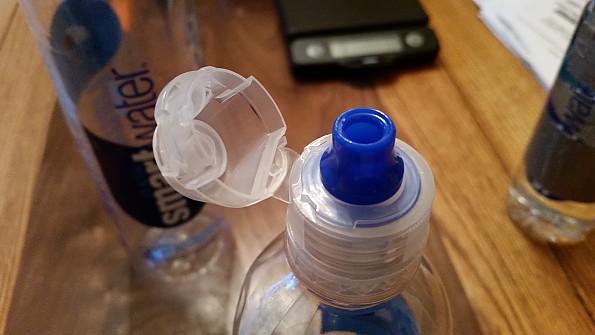
The smooth sides and thin shape on these bottles make them very easy to slip in and out of a side pocket on the pack if you don't carry a sipper bottle like me or carry more than one. However, you probably should be careful if your pockets are low that they don't slip out. Both my regular backpacks have deep side pockets so this hasn't been an issue for me.
One of the main benefits of using the Smartwater brand is that their threads fit a regular Sawyer water filter. Most other disposables do not. While I usually use a Platypus or the Sawyer bag (although it can have issues) on the filter, it is nice to have this option especially when it is easier to use a bottle to collect the water, which happens occasionally depending on the source.
The light weight and variety of size allow for a flexible approach to water storage. I always carry a sipper bottle and a Platypus soft bottle, then supplement with additional water bottles (like the 1L) or another bag type storage depending on the time of year and terrain. In fact you will often find me with up to four different storage containers as I do a lot of dry camps well away from streams.
You can see three bottles in the photo below along with the Sawyer water bag on the right (and there is a hidden 2L Platypus as well) as I was loading up at an AT shelter source before taking back off onto wilderness trails and camping on a dry ridge. I usually carry most of them empty and load up like a mule for the last hour or two so I have a surplus of water for the evening through lunch the next day just in case.
These bottles are so light that carrying an extra is a question only of space, not weight.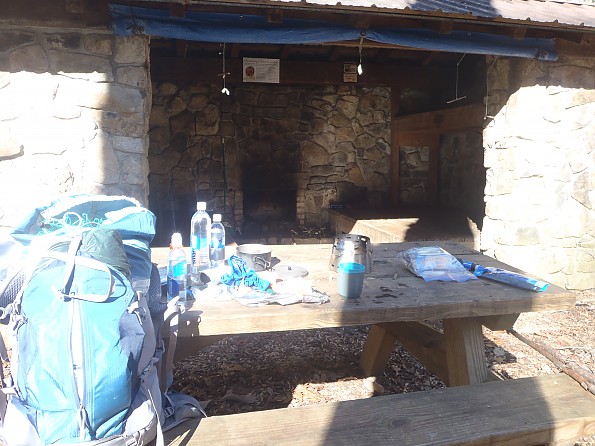
I also tend to use one of these bottles for storing alcohol for my stove on longer trips where my standard container may be a bit small. In fact now that I think about it, one of the bottles in the photo above is a fuel container. I have stored alcohol (not gas!) in one of these bottles for up to 6 months and seen no decrease in fuel efficiency or degradation of the plastic. Just make sure you CLEARLY distinguish the fuel from the water — I store my duct tape there.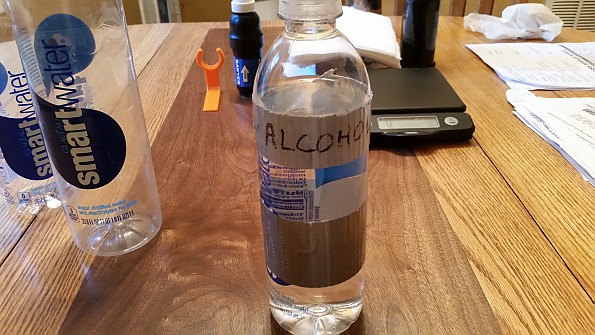
OK, I guess I have to mention the "free water" that comes with the bottle...
Negatives:
As I mentioned above, the negatives of the Smartwater bottle for backpacking are basically the same negatives for any disposable bottle (therefore the high rating).
- Long term durability of any non-designed water bottle is suspect at minimum. I have used bottles for at least a year with no issues, but tend to acquire another one or two by then and switch them out.
- They freeze much more quickly than a Nalgene and I would not recommend using them in winter. I have used them into the low teens without issues, but keep the bottles inside the tent where the air is warmer.
- Thin mouth on the bottle is easier to drink from (in my opinion) but some like wider mouths better for drinking, collecting water, or being able to use a device like a Steripen.
- They don't handle boiling water, which is another reason not to use them in winter (snow melting). In addition they are not dishwasher safe when you get home...even if they were see the next bullet for reasons I wouldn't do either of these.
- Long term use of these cheap bottles may have health issues related to the chemicals released into the water. The main one you hear about is BPA. However, if you look at recent articles and research, others like BPS are maybe just as much an issue and are apparently in most plastics including those of permanent water bottles. I am not an expert in this area, so don't begin to claim that anything is safe or dangerous.
Probably the biggest negative to me is the sustainability of these bottles. I carry Nalgene or stainless steel every day, but occasionally am in a situation where I need a bottle of water on the road. In that event, I will buy Smartwater over other brands so I can reuse rather than recycle the bottle.
Sustainability of any cheap plastic bottle is terrible, as it takes about three times the amount of water to make one than it can hold. They don't biodegrade for thousands of years. The more I write about this, the guiltier I feel for this review if it promotes purchase of these bottles.
If you have one re-use it instead of recycling, but don't buy it just for this use!
Source: bought it new
Price Paid: $1-2 depending on sales and size

